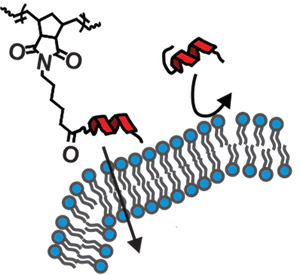UC San Diego Among Multidisciplinary Awards Providing $221M Nationally for Cutting-Edge Projects
Technology & Engineering
Brushing Up Peptides Boosts their Potential as Drugs
Peptides promise to be useful drugs, but they’re hard to handle.

On their own peptides (shown as red helices) can’t easily penetrate the membrane of a cell. Adding a small, brushlike group of atoms helps them through.
Because peptides, like proteins, are chains of amino acids, our bodies will digest them and excrete the remnants. Even if delivered to their targets intact through intravenous injection, peptides mostly can’t get into cells without help.
Chemists at the University of California, San Diego, have found a simple, potentially broadly useful way to send peptides into cells and tissues.
“We have this platform that could revolutionize peptide therapeutics,” said graduate student Jacquelin Kammeyer, who helped to develop the new method.
“People discover interesting drug candidates that prove difficult to use. If the medicine can’t be swallowed in a pill, it ends up being used only for last-resort, ‘salvage’ treatments,” said postdoctoral fellow Angela Blum. Blum and Kammeyer contributed equally to the study. Nathan Gianneschi, assistant professor of chemistry and biochemistry, guided the effort.
Peptides can be protected from digestion by arranging them as a densely packaged brush, Gianneschi’s group has shown in earlier work. Now they report in the journal Chemical Science that the brushes can help peptides enter cells without changing their biological function.
The brush, a densely branching polymer, presents an overall, highly charged set of amino acids to the environment surrounding these molecules, which likely helps them to get inside cells.
Many molecules that stud the surfaces of cells hold a negative charge. The tip of one amino acid, arginine, holds a small positive charge. The polymer brushes chain multiple copies of this particular group of atoms, boosting the positive charge.
The exact means of entry into the cells aren’t fully understood, but the researchers believe the charged brush helps the membrane engulf the peptide.
The group worked out their system on a “nonsense” peptide that has no known function in cells, but could be manipulated to attach varied appendages at different positions along the amino acid chain.
They then tested their strategy on a therapeutic peptide called KLA, which could prove useful for fighting cancer because it causes cells to self-destruct, but is unable to enter cells on its own. Once incorporated into a dense brush, KLA was able to enter cells and retained its killing power.
The chemical procedure required to alter the peptide to create a cell-penetrating polymer brush is relatively simple. The brushes can be attached to either of two specific amino acids, arginine or lysine, in the peptide chain, and either could also be added to the end of a peptide that is lacking these attachment points.
The versatility of their method allows modification of a wide variety of peptides in this way and could enable the development of peptide based drugs to treat a broad range of illnesses.
A patent is pending for this technology. Contact Skip Cynar in the campus Technology Transfer Office at scynar@ucsd.edu or 858.822.2672 for licensing information.
Funding for the work was provided by the National Institutes of Health through a Director’s New Innovator Award, a Common Fund Transformative Research Award, and a research grant through the National Institute of Biomedical Imaging and Bioengineering; the Air Force Office of Scientific Research Presidential through an Early Career Award for Scientists and Engineers and a Basic Research Initiative grant. Blum is supported by the American Cancer Society’s North Texans Creating Tomorrow’s Miracles Postdoctoral Fellowship. This research made use of the UC San Diego School of Medicine Microscopy Core which is supported by a core grant from the National Institute of Neurological Disorders and Stroke.
Keep up with all the latest from UC San Diego. Subscribe to the newsletter today.